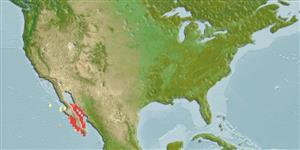>
Ophidiiformes (Cusk eels) >
Ophidiidae (Cusk-eels) > Ophidiinae
Etymology: Lepophidium: Latin, lepus, leporis = rabbit + Greek, ophis = serpent (Ref. 45335).
More on author: Gilbert.
Environment: milieu / climate zone / depth range / distribution range
Écologie
marin démersal; profondeur 20 - 238 m (Ref. 36413). Subtropical; 29°N - 21°N, 119°W - 110°W (Ref. 91765)
Eastern Pacific: from the Gulf of California (Bahía de Los Angeles in the northern Gulf to Bahía de La Paz in the south) and from the outer coast of Baja California (Cedros Island) up to near the southern tip of the peninsula.
Taille / Poids / Âge
Maturity: Lm ? range ? - ? cm
Max length : 24.6 cm SL mâle / non sexé; (Ref. 91765)
Épines dorsales (Total) : 0; Rayons mous dorsaux (Total) : 123 - 131; Épines anales: 0; Rayons mous anaux: 103 - 109; Vertèbres: 80 - 84. This species is characterized by the following: usual number of vertebrae, precaudal 14 (rarely 13), caudal 53-54 (55), total 81-82 (80-84); number of fin rays, dorsal 123-131, anal 103-109, pectoral usually 20-21 (19-24); pyloric caeca usually 6 (5-7) in 2 whorls, usually 5-6+1; first gill arch with rudimentary rakers 4 (3-6) on the upper arm, 8 (7-10) developed rakers on the lower limb, 5-9 rudimentary rakers anteriorly on the first arch; total rakers 16-19; dorsal-fin origin often between neural spines 4-5 (11 specimens) and rarely between 2-3 or 3-4 (1 specimen) (Ref. 91765).
Rare species (Ref. 34024) inhabiting soft bottom (Ref. 9329). Oviparous, with planktonic larvae (Ref. 36413). Oval, pelagic eggs float in a gelatinous mass (Ref. 205). Little is known of this species (Ref. 9329).
Life cycle and mating behavior
Maturité | Reproduction | Frai | Œufs | Fécondité | Larves
Robins, C.R., R.H. Robins and M.E. Brown, 2012. A revision of Lepophidium (Teleoastei, Ophidiidae), with descriptions of eight new species. Bulletin of the Florida Museum of Natural History 52(1):1-94. (Ref. 91765)
Statut dans la liste rouge de l'IUCN (Ref. 130435: Version 2024-2)
Menace pour l'homme
Harmless
Utilisations par l'homme
Pêcheries: sans intérêt
Outils
Articles particuliers
Télécharger en XML
Sources Internet
Estimates based on models
Phylogenetic diversity index (Ref.
82804): PD
50 = 0.5000 [Uniqueness, from 0.5 = low to 2.0 = high].
Bayesian length-weight: a=0.00102 (0.00046 - 0.00225), b=3.06 (2.88 - 3.24), in cm total length, based on all LWR estimates for this body shape (Ref.
93245).
Niveau trophique (Ref.
69278): 3.6 ±0.7 se; based on size and trophs of closest relatives
Résilience (Ref.
120179): Haut, temps minimum de doublement de population inférieur à 15 mois (Preliminary K or Fecundity.).
Fishing Vulnerability (Ref.
59153): Low vulnerability (20 of 100).
